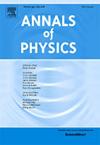三能级系统的微扰解析解:三态Rabi模型和线性化的三量子点穿梭
IF 3
3区 物理与天体物理
Q2 PHYSICS, MULTIDISCIPLINARY
引用次数: 0
摘要
本文从摄动理论的角度给出了三态拉比模型(3SRM)和线性化三量子点穿梭(TQDS)的解析解。3SRM是拉比哈密顿量的直接三态扩展,其中泡利矩阵σ´x和σ´z分别被自旋为1的矩阵J´x和J´z所取代。TQDS是由三个量子点(QDs)组成的线性阵列组成的纳米机电系统,每个量子点都有一个能级参与动力学,其中中心量子点由一个简单的量子谐振子建模,该谐振子在外部量子点之间振荡,保持固定。当栅极电压加在外量子点上时,电子输运是通过从源极到漏极以受控方式隧穿而产生的。两个模型的哈密顿量都是由三个重要的能量贡献建立的:一个来自振荡,另一个对应于位能(原子哈密顿量),最后一个是指电子态和振荡模式之间的相互作用。在微扰理论格式中,我们分析了每个模型的两种情况,其中相互作用哈密顿量或原子哈密顿量被用作微扰。我们计算了最多修正到二阶的能量,以及相应的特征态。所得的解析结果与数值精确解和先前在绝热近似下计算的解析解进行了比较。对于3SRM,我们发现摄动方法给出的结果仅限于摄动参数的小值;然而,对于结合简并微扰理论的TQDS,我们能够在能谱中再现反交叉,从而补充了使用绝热近似获得的结果。本文章由计算机程序翻译,如有差异,请以英文原文为准。
A perturbative analytical solution for 3-level systems: The 3-State Rabi model and the linearized Triple-Quantum-Dot Shuttle
In this paper we present an analytical solution for the 3-State Rabi model (3SRM) and linearized Triple-Quantum-Dot Shuttle (TQDS) from the perspective of perturbation theory. The 3SRM is an immediate three-state extension of the Rabi Hamiltonian, where the Pauli matrices and are replaced by the spin-1 matrices and , respectively. The TQDS is a nanoelectromechanical system consisting of a linear array of three quantum dots (QDs), with one energy level in each dot participating in the dynamics, and where the central QD is modeled by a simple quantum harmonic oscillator that oscillates between the outer QDs, which are kept fixed. When a gate voltage is applied to the outer QDs, electronic transport is induced by tunneling from a source to a drain in a controlled manner. The Hamiltonian of both models is built from three important energetic contributions: one coming from the oscillation, another corresponding to the site energy (atomic Hamiltonian) and a last one that refers to the interaction between the electronic states and the oscillation modes. In the perturbation theory scheme, we analyze two cases for each model, where either the interaction Hamiltonian or the atomic Hamiltonian is used as the perturbation. We calculate the energies corrected to second order at most, and the corresponding eigenstates. The analytical results obtained were compared with the numerically exact solution and an analytical solution previously calculated in the adiabatic approximation regime. For the 3SRM we find that the perturbative approach gives results limited to small values of the perturbing parameter; however, for the TQDS, incorporating degenerate perturbation theory, we are able to reproduce anticrossings in the energy spectrum, thus complementing the results obtained using the adiabatic approximation.
求助全文
通过发布文献求助,成功后即可免费获取论文全文。
去求助
来源期刊

Annals of Physics
物理-物理:综合
CiteScore
5.30
自引率
3.30%
发文量
211
审稿时长
47 days
期刊介绍:
Annals of Physics presents original work in all areas of basic theoretic physics research. Ideas are developed and fully explored, and thorough treatment is given to first principles and ultimate applications. Annals of Physics emphasizes clarity and intelligibility in the articles it publishes, thus making them as accessible as possible. Readers familiar with recent developments in the field are provided with sufficient detail and background to follow the arguments and understand their significance.
The Editors of the journal cover all fields of theoretical physics. Articles published in the journal are typically longer than 20 pages.
 求助内容:
求助内容: 应助结果提醒方式:
应助结果提醒方式:


